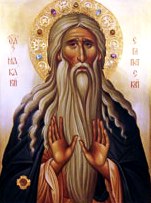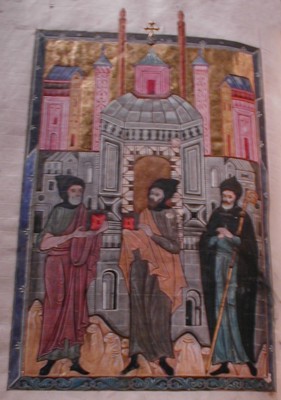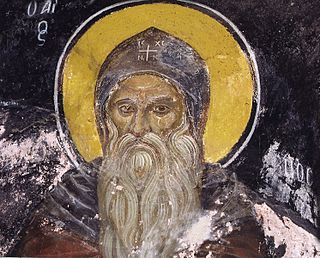Related Research Articles

Macarius of Egypt was a Christian monk and grazer hermit. He is also known as Macarius the Elder or Macarius the Great.

Saint Macarius of Alexandria was a monk in the Nitrian Desert. He was a slightly younger contemporary of Macarius of Egypt, and is thus also known as Macarius the Younger.

The Desert Fathers were early Christian hermits and ascetics, who lived primarily in the Scetes desert of the Roman province of Egypt, beginning around the third century AD. The Apophthegmata Patrum is a collection of the wisdom of some of the early desert monks and nuns, in print as Sayings of the Desert Fathers. The first Desert Father was Paul of Thebes, and the most well known was Anthony the Great, who moved to the desert in AD 270–271 and became known as both the father and founder of desert monasticism. By the time Anthony had died in AD 356, thousands of monks and nuns had been drawn to living in the desert following Anthony's example, leading his biographer, Athanasius of Alexandria, to write that "the desert had become a city." The Desert Fathers had a major influence on the development of Christianity.

Melania the Elder, Latin Melania Maior was a Desert Mother who was an influential figure in the Christian ascetic movement that sprang up in the generation after the Emperor Constantine made Christianity a legal religion of the Roman Empire. She was a contemporary of, and well known to, Abba Macarius and other Desert Fathers in Egypt, Jerome, Augustine of Hippo, Paulinus of Nola, and Evagrius of Pontus, and she founded two religious communities on the Mount of Olives in Jerusalem. She stands out for the convent she founded for herself and the monastery she established in honour of Rufinus of Aquileia, which belongs to the earliest Christian communities, and because she promoted the asceticism which she, as a follower of Origen, considered indispensable for salvation.

Kellia, referred to as "the innermost desert", was a 4th-century Egyptian Christian monastic community spread out over many square kilometers in the Nitrian Desert about 65 km (40 mi) south of Alexandria. It was one of three centers of monastic activity in the region, along with Nitria and Scetis. It is called al-Muna in Arabic and was inhabited until the 9th century. Only archaeological sites remain there today.

Evagrius Ponticus, also called Evagrius the Solitary, was a Christian monk and ascetic from Heraclea, a city on the coast of Bithynia in Asia Minor. One of the most influential theologians in the late fourth-century church, he was well known as a thinker, polished speaker, and gifted writer. He left a promising ecclesiastical career in Constantinople and traveled to Jerusalem, where in 383 AD he became a monk at the monastery of Rufinus and Melania the Elder. He then went to Egypt and spent the remaining years of his life in Nitria and Kellia, marked by years of asceticism and writing. He was a disciple of several influential contemporary church leaders, including Basil of Caesarea, Gregory of Nazianzus, and Macarius of Egypt. He was a teacher of others, including John Cassian and Palladius of Galatia.

Wadi El Natrun is a depression in northern Egypt that is located 23 m (75 ft) below sea level and 38 m (125 ft) below the Nile River level. The valley contains several alkaline lakes, natron-rich salt deposits, salt marshes and freshwater marshes.
The Nitrian Desert is a desert region in northwestern Egypt, lying between Alexandria and Cairo west of the Nile Delta. It is known for its history of Christian monasticism.

Pambo of Nitria was a Coptic Desert Father of the fourth century and disciple of Anthony the Great. His feast day is July 18 among the Oriental Orthodox, Eastern Orthodox, and Catholic churches.
Abraham of Scetis was a monk who became a saint of the Coptic Church.

The Sayings of the Desert Fathers is the name given to various textual collections consisting of stories and sayings attributed to the Desert Fathers from approximately the 5th century AD.
Monasticism is a way of life where a person lives outside of society, under religious vows.
The Tall Brothers were four brothers among the Egyptian monks of Nitria in the fifth century by the names of Ammonius, Dioscorus, Eusebius, and Euthymius. They were referred to as the "Tall Brothers" because they were tall in stature and commanding in appearance.
Nitria is one of the earliest Christian monastic sites in Egypt and is located in the Nitrian Desert. It was the first of the three major centers of Christian monastic activity in the Lower Egypt, the other two being Kellia and Scetis.
Cronius of Nitria was an Egyptian Christian monk who lived in Nitria, Lower Egypt. He was one of the Desert Fathers.
Abba Agathon was an Egyptian Orthodox Christian monk and saint who lived around the 4th century in Scetis, Lower Egypt and was known for his meekness and discernment. He was a disciple of Abba Lot and Abba Poemen and a contemporary of notable Desert Fathers Amun, Macarius, Joseph and Peter. He is venerated as a saint in the Orthodox Church on 2 March. Agathon was one of the Desert Fathers.
AbbaLot was an Egyptian Orthodox Christian monk and saint who lived around the 4th and 5th centuries in a monastery near Arsinoe (Al-Fayoum), lower Egypt, by a marshy lake. Abba Lot "...directed many brethren on the path to salvation." He was one of the Desert Fathers.
Chaeremon or Cherimon was an Egyptian Christian monk who lived around the 4th and 5th centuries AD in the Nitrian Desert of Lower Egypt. He was one of the Desert Fathers.
Or of Nitria was an Egyptian Orthodox Christian ascetic who lived around the 4th century AD in Egypt in Dalga, Nitria, the Thebaid, and in the deserts around Shaina. He is one of the lesser-known Desert Fathers, but is nevertheless regarded as one of the "chief among monks", being "a man who stood out among many of the fathers". He is associated with Theodore and Sisoes the Great. According to Jerome, at one point during his life, Or was the father of "one thousand [cenobitic] monks" in the Egyptian Desert. Or died c. 390.
Euprepius of Egypt was an Egyptian Orthodox Christian monk, ascetic, and saint who lived around the 4th century. All of his recorded sayings exist in the Sayings of the Desert Fathers, and little else is known about him.
References
- 1 2 Ward, Benedicta (1984). The sayings of the Desert Fathers: the alphabetical collection. Kalamazoo, MI: Cistercian Publications. ISBN 0-87907-959-2.